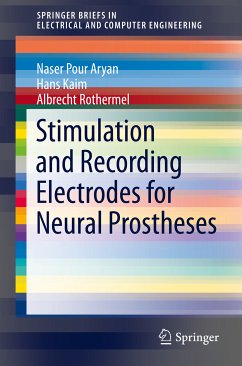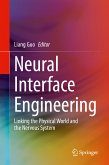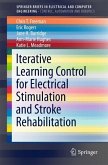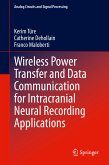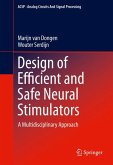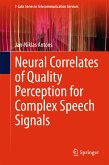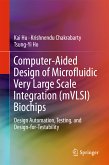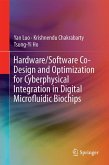Naser Pour Aryan, Hans Kaim, Albrecht Rothermel
Stimulation and Recording Electrodes for Neural Prostheses (eBook, PDF)
53,49 €
inkl. MwSt.
Sofort per Download lieferbar
Naser Pour Aryan, Hans Kaim, Albrecht Rothermel
Stimulation and Recording Electrodes for Neural Prostheses (eBook, PDF)
- Format: PDF
- Merkliste
- Auf die Merkliste
- Bewerten Bewerten
- Teilen
- Produkt teilen
- Produkterinnerung
- Produkterinnerung

Bitte loggen Sie sich zunächst in Ihr Kundenkonto ein oder registrieren Sie sich bei
bücher.de, um das eBook-Abo tolino select nutzen zu können.
Hier können Sie sich einloggen
Hier können Sie sich einloggen
Sie sind bereits eingeloggt. Klicken Sie auf 2. tolino select Abo, um fortzufahren.

Bitte loggen Sie sich zunächst in Ihr Kundenkonto ein oder registrieren Sie sich bei bücher.de, um das eBook-Abo tolino select nutzen zu können.
This book provides readers with basic principles of the electrochemistry of the electrodes used in modern, implantable neural prostheses. The authors discuss the boundaries and conditions in which the electrodes continue to function properly for long time spans, which are required when designing neural stimulator devices for long-term in vivo applications. Two kinds of electrode materials, titanium nitride and iridium are discussed extensively, both qualitatively and quantitatively. The influence of the counter electrode on the safety margins and electrode lifetime in a two electrode system is…mehr
- Geräte: PC
- ohne Kopierschutz
- eBook Hilfe
- Größe: 3.56MB
- Upload möglich
Andere Kunden interessierten sich auch für
![Neural Interface Engineering (eBook, PDF) Neural Interface Engineering (eBook, PDF)]() Neural Interface Engineering (eBook, PDF)73,95 €
Neural Interface Engineering (eBook, PDF)73,95 €![Iterative Learning Control for Electrical Stimulation and Stroke Rehabilitation (eBook, PDF) Iterative Learning Control for Electrical Stimulation and Stroke Rehabilitation (eBook, PDF)]() Chris T. FreemanIterative Learning Control for Electrical Stimulation and Stroke Rehabilitation (eBook, PDF)53,49 €
Chris T. FreemanIterative Learning Control for Electrical Stimulation and Stroke Rehabilitation (eBook, PDF)53,49 €![Wireless Power Transfer and Data Communication for Intracranial Neural Recording Applications (eBook, PDF) Wireless Power Transfer and Data Communication for Intracranial Neural Recording Applications (eBook, PDF)]() Kerim TüreWireless Power Transfer and Data Communication for Intracranial Neural Recording Applications (eBook, PDF)53,49 €
Kerim TüreWireless Power Transfer and Data Communication for Intracranial Neural Recording Applications (eBook, PDF)53,49 €![Design of Efficient and Safe Neural Stimulators (eBook, PDF) Design of Efficient and Safe Neural Stimulators (eBook, PDF)]() Marijn van DongenDesign of Efficient and Safe Neural Stimulators (eBook, PDF)90,94 €
Marijn van DongenDesign of Efficient and Safe Neural Stimulators (eBook, PDF)90,94 €![Neural Correlates of Quality Perception for Complex Speech Signals (eBook, PDF) Neural Correlates of Quality Perception for Complex Speech Signals (eBook, PDF)]() Jan-Niklas AntonsNeural Correlates of Quality Perception for Complex Speech Signals (eBook, PDF)96,29 €
Jan-Niklas AntonsNeural Correlates of Quality Perception for Complex Speech Signals (eBook, PDF)96,29 €![Computer-Aided Design of Microfluidic Very Large Scale Integration (mVLSI) Biochips (eBook, PDF) Computer-Aided Design of Microfluidic Very Large Scale Integration (mVLSI) Biochips (eBook, PDF)]() Kai HuComputer-Aided Design of Microfluidic Very Large Scale Integration (mVLSI) Biochips (eBook, PDF)96,29 €
Kai HuComputer-Aided Design of Microfluidic Very Large Scale Integration (mVLSI) Biochips (eBook, PDF)96,29 €![Hardware/Software Co-Design and Optimization for Cyberphysical Integration in Digital Microfluidic Biochips (eBook, PDF) Hardware/Software Co-Design and Optimization for Cyberphysical Integration in Digital Microfluidic Biochips (eBook, PDF)]() Yan LuoHardware/Software Co-Design and Optimization for Cyberphysical Integration in Digital Microfluidic Biochips (eBook, PDF)96,29 €
Yan LuoHardware/Software Co-Design and Optimization for Cyberphysical Integration in Digital Microfluidic Biochips (eBook, PDF)96,29 €-
-
-
This book provides readers with basic principles of the electrochemistry of the electrodes used in modern, implantable neural prostheses. The authors discuss the boundaries and conditions in which the electrodes continue to function properly for long time spans, which are required when designing neural stimulator devices for long-term in vivo applications. Two kinds of electrode materials, titanium nitride and iridium are discussed extensively, both qualitatively and quantitatively. The influence of the counter electrode on the safety margins and electrode lifetime in a two electrode system is explained. Electrode modeling is handled in a final chapter.
Produktdetails
- Produktdetails
- Verlag: Springer International Publishing
- Erscheinungstermin: 29. September 2014
- Englisch
- ISBN-13: 9783319100524
- Artikelnr.: 43795067
- Verlag: Springer International Publishing
- Erscheinungstermin: 29. September 2014
- Englisch
- ISBN-13: 9783319100524
- Artikelnr.: 43795067
Naser Pour Aryan received the B.E. degree in electrical engineering from Ferdowsi University of Mashhad, Iran, in 2005 and the M.Sc. degree in communication technology from the University of Ulm, Germany, in 2008. He received his Ph.D. degree from the University of Ulm in December 2013. He has been working as a researcher on the retinal prosthesis project at the University of Ulm since January 2008, studying and characterizing neural stimulation electrodes. He
has had several publications on this topic. Dr. Pour Aryan’s research interests include mainly electrochemistry, analog and mixed signal circuits, modeling passive electrical structures, image processing and optics.
Hans Kaim received the Dipl.-Ing. degree in electrical engineering
from the University of Ulm, Germany, in 2013. He has been working as a researcher on the retinal prosthesis project at the University of Ulm since January 2013, investigating and characterizing neural stimulation electrodes. His research interests include electrochemistry, modeling passive electrical structures and analog and mixed signal circuits.
Albrecht Rothermel (M’90, SM’95) received the Dipl.-Ing.
degree in electrical engineering from the University of Dortmund,
and the Dr.-Ing. (Ph.D.) degree from the University of Duisburg, both Germany, in 1984 and 1989, respectively. From 1985 to 1989, he was with the Fraunhofer Institute of Microelectronic Circuits and Systems, Duisburg, Germany, working on integrated digital CMOS and BiCMOS circuits for high-speed applications. From 1990 to 1993, he was with Thomson Consumer Electronics (Thomson multimedia), Corporate Research, Villingen-Schwenningen, Germany. He worked on digital signal processing concepts for present and future TV and HDTV sets. Then as Manager of the IC design
laboratory, he was involved in analog and mixed circuit design for audio and video. Since 1994, he has been with the Institute of Microelectronics, Universityof Ulm, Germany, as a Professor of Electrical Engineering. His research interests include analog and mixed signal circuits for various applications including implantable
sensors and stimulators, and digital signal processing algorithms for video applications, mostly in automotive environments. Dr. Rothermel was a guest scientist at Thomson Multimedia in Indianapolis, USA
(1997), at the Edith-Cowan University in Perth, WA (2003), and at the Shandong University in Jinan, China (2006). He has published more than 130 papers, book chapters and patents. He received the 1985 outstanding young scientist award of the German VDE, the 1991 outstanding publication award of the German GME, the 2003 award for remarkable cooperation between industry and university, and the 2006 best paper award of the IEEE ICCE. After acting as associate editor of the IEEE JSSC, TPC-Chair of the IEEE ICCE-B, and distinguished lecturer of the IEEE, he now is a member of the program committees of ESSCIRC, and ICCE. He is member of the German Society of Electrical Engineers (VDE), the German TV and Cinema Technology Society (FKTG), and senior member of the IEEE.
has had several publications on this topic. Dr. Pour Aryan’s research interests include mainly electrochemistry, analog and mixed signal circuits, modeling passive electrical structures, image processing and optics.
Hans Kaim received the Dipl.-Ing. degree in electrical engineering
from the University of Ulm, Germany, in 2013. He has been working as a researcher on the retinal prosthesis project at the University of Ulm since January 2013, investigating and characterizing neural stimulation electrodes. His research interests include electrochemistry, modeling passive electrical structures and analog and mixed signal circuits.
Albrecht Rothermel (M’90, SM’95) received the Dipl.-Ing.
degree in electrical engineering from the University of Dortmund,
and the Dr.-Ing. (Ph.D.) degree from the University of Duisburg, both Germany, in 1984 and 1989, respectively. From 1985 to 1989, he was with the Fraunhofer Institute of Microelectronic Circuits and Systems, Duisburg, Germany, working on integrated digital CMOS and BiCMOS circuits for high-speed applications. From 1990 to 1993, he was with Thomson Consumer Electronics (Thomson multimedia), Corporate Research, Villingen-Schwenningen, Germany. He worked on digital signal processing concepts for present and future TV and HDTV sets. Then as Manager of the IC design
laboratory, he was involved in analog and mixed circuit design for audio and video. Since 1994, he has been with the Institute of Microelectronics, Universityof Ulm, Germany, as a Professor of Electrical Engineering. His research interests include analog and mixed signal circuits for various applications including implantable
sensors and stimulators, and digital signal processing algorithms for video applications, mostly in automotive environments. Dr. Rothermel was a guest scientist at Thomson Multimedia in Indianapolis, USA
(1997), at the Edith-Cowan University in Perth, WA (2003), and at the Shandong University in Jinan, China (2006). He has published more than 130 papers, book chapters and patents. He received the 1985 outstanding young scientist award of the German VDE, the 1991 outstanding publication award of the German GME, the 2003 award for remarkable cooperation between industry and university, and the 2006 best paper award of the IEEE ICCE. After acting as associate editor of the IEEE JSSC, TPC-Chair of the IEEE ICCE-B, and distinguished lecturer of the IEEE, he now is a member of the program committees of ESSCIRC, and ICCE. He is member of the German Society of Electrical Engineers (VDE), the German TV and Cinema Technology Society (FKTG), and senior member of the IEEE.
Stimulation and recording electrodes: General concepts.- Irreversible and reversible redox reactions: Water window.- Charge balance and safe operation conditions.- Primary current distribution and electrode geometry.- Experiments hardware and methods.- Electrode materials: State-of-the-art and experiments.- The effect of the counter electrode on stimulation electrode lifetime.- Electrode modeling for titanium nitride, iridium and iridium oxide microelectrodes.- Summary.
Stimulation and recording electrodes: General concepts.- Irreversible and reversible redox reactions: Water window.- Charge balance and safe operation conditions.- Primary current distribution and electrode geometry.- Experiments hardware and methods.- Electrode materials: State-of-the-art and experiments.- The effect of the counter electrode on stimulation electrode lifetime.- Electrode modeling for titanium nitride, iridium and iridium oxide microelectrodes.- Summary.
Stimulation and recording electrodes: General concepts.- Irreversible and reversible redox reactions: Water window.- Charge balance and safe operation conditions.- Primary current distribution and electrode geometry.- Experiments hardware and methods.- Electrode materials: State-of-the-art and experiments.- The effect of the counter electrode on stimulation electrode lifetime.- Electrode modeling for titanium nitride, iridium and iridium oxide microelectrodes.- Summary.
Stimulation and recording electrodes: General concepts.- Irreversible and reversible redox reactions: Water window.- Charge balance and safe operation conditions.- Primary current distribution and electrode geometry.- Experiments hardware and methods.- Electrode materials: State-of-the-art and experiments.- The effect of the counter electrode on stimulation electrode lifetime.- Electrode modeling for titanium nitride, iridium and iridium oxide microelectrodes.- Summary.
